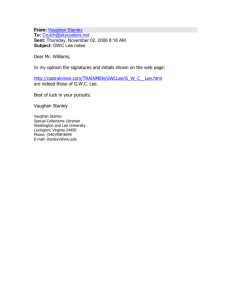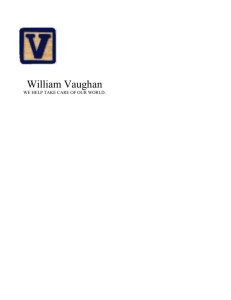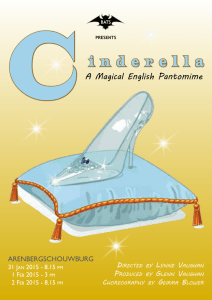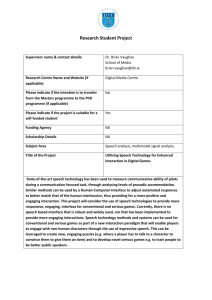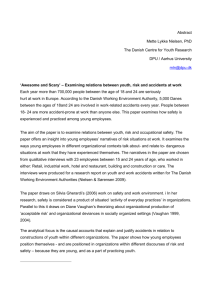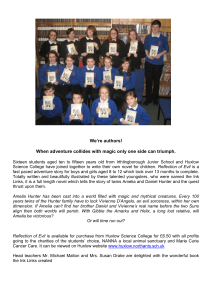Room 12 - Romanticism in the 1940`s (Word)
advertisement
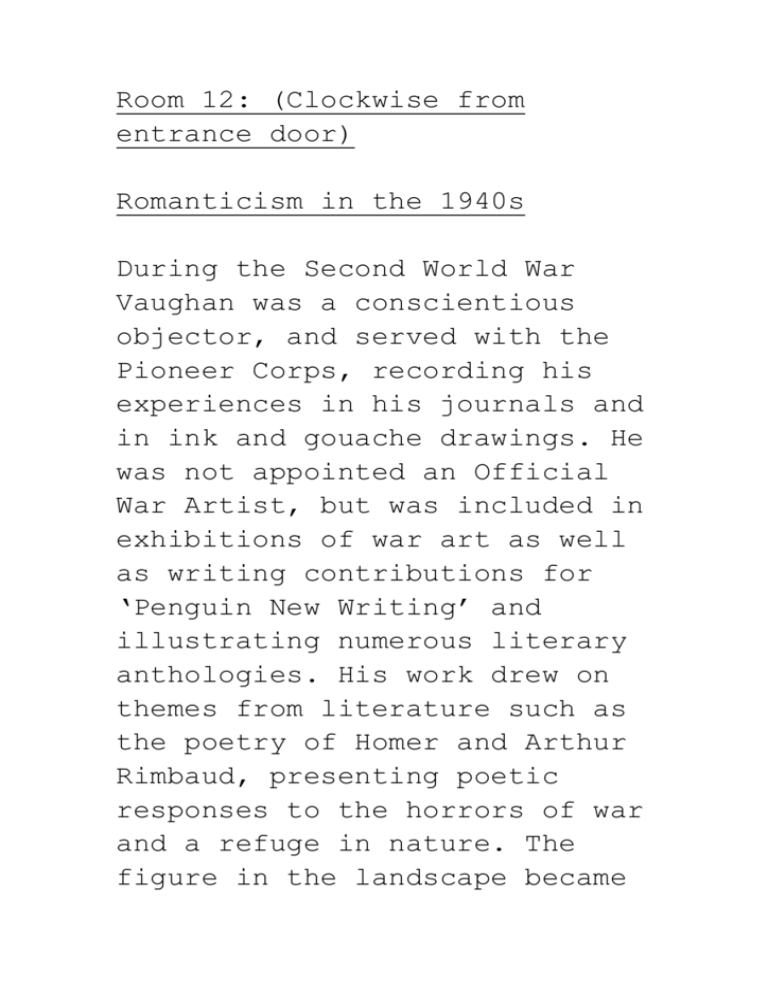
Room 12: (Clockwise from entrance door) Romanticism in the 1940s During the Second World War Vaughan was a conscientious objector, and served with the Pioneer Corps, recording his experiences in his journals and in ink and gouache drawings. He was not appointed an Official War Artist, but was included in exhibitions of war art as well as writing contributions for ‘Penguin New Writing’ and illustrating numerous literary anthologies. His work drew on themes from literature such as the poetry of Homer and Arthur Rimbaud, presenting poetic responses to the horrors of war and a refuge in nature. The figure in the landscape became a key theme in Vaughan’s work, and he came to be seen as a leading figure in the group of artists dubbed the ‘NeoRomantics’, which included Graham Sutherland, John Piper, John Minton, Michael Ayrton, Robert Colquhoun and Robert MacBryde. In the late 1940s Vaughan’s work explored the alienation of the post-war years, painting psychologically intense groups of figures in room settings which were to lead to his large format figure paintings of the 1950s and 1960s. Seated Boy Circa 1937-8 Oil on cardboard Collection of John Allen F.R.S.A. This early example of a male nude from the late 1930s was painted whilst Vaughan was working at Lintas, the advertising arm of Lever Brothers. The pose and monumental quality of this painting reflects Vaughan’s awareness of Pablo Picasso’s Neo-Classical nudes of the 1920s, such as the celebrated painting of two youths on a sea shore ‘The Pipes of Pan (1923). Vaughan had visited Paris, Toulon and Cassis in 1937, and in London he frequently visited exhibitions of modern art including Picasso and Matisse. Ulysses II Circa 1938 Oil on paper Collection of John Allen Collection F.R.S.A In 1938 Vaughan created a series of paintings of male figures on the shoreline with titles that make reference to the classical myth of Ulysses, the hero of Homer’s epic poem ‘The Odyssey’. The poem describes Ulysses travails as he tries to return home to Ithaca with his crew after the Trojan War, suffering shipwrecks and adventures. This classical subject of figures on the shoreline is an extension of his paintings of bathers on the beach at this time. Lighthouse 2 1945 Ink and crayon on paper Private Collection, London The lighthouse in this painting with its multiple faces and many outstretched arms is possibly a reference to the myth of Hero and Leander, or to the Sirens that lure the Greek hero Ulysses onto their island. The overlapping profiles reflect Vaughan’s appreciation for the paintings of Pablo Picasso in the late 1930s and his awareness of Surrealism. Two Figures by the Shore Circa 1942 Pen, ink and wash on paper Private Collection, London Night in the Streets of the City 1943 Indian ink, gouache and crayon on paper Private Collection, West Sussex In July 1943 Vaughan wrote in his journal: “I do not paint as a result of visual experience, or from any positive urge to expression. I start with an excited awareness of certain materials, Indian ink, white paint, ochre, chalk, and a more or less contained predisposition for certain forms, the stone circle, rock forms, elemental non-precise forms and seek to arrange them in a way which will relieve and satisfy me. As every possible known or unknown arrangement is open to me, the question of which to use becomes bewitching.” Seligheit 1944 Ink and collage on wash paper Private Collection During the Second World War Vaughan worked as a German translator in a prisoner of war camp. The precise meaning of the title is unclear: ‘Seligheit’ can be translated as ‘blessed protection’ or ‘Seligkeit’ as ‘Salvation’. Both could be correct as the landscape seems to offer protection, or least solace, from the war. The collaged ink drawings provide an insight into his way of working, and bringing together compositional ideas. It relates closely to the drawing ‘Man in a Cave’ shown alongside, and to some of his designs based on the poetry of Arthur Rimbaud. Man in a Cave 1943 Gouache and ink on paper (with wax resist?) Private collection courtesy Osborne Samuel Gallery, London This ink wash drawing of a nude male sheltering in a rocky cave reflects the technique of Henry Moore’s ink drawings of civilians sheltering from the Blitz during the Second World War. The vulnerability of the figure, curled up in an almost foetal position, seems to be a wider metaphor for humanity during the war. In Vaughan’s image it is nature that seems to offer a form of protection from the horrors of war. Lovers I 1946 Gouache, ink and crayon on paper Dr Mark Cecil Collection This image of a couple embracing reflects a tender side of Vaughan’s work and a reflection on intimacy during the war years and immediately after. In his journal he observed: ‘In this setting one could hardly expect to find man standing confidently alone. But in huddled groups, separate forms hardly distinguishable, merged together they create a certain steady glow of humanness. Or else as lovers, locked in each other, a single bipolar entity, oblivious to the outside, reaffirming each his existence in the other. And the threat of parting never very far away.’ Two Labourers Lighting a Cigarette 1946 Gouache, ink and crayon on paper Anthony Hepworth, Bath Vaughan wrote in his journal of being drawn to: ‘a state of tension, which results when two different things of different natures are brought together. A figure in a landscape, the natural world and the human world, a man lighting his cigarette from the butt of another’s – the essential separateness of individuals momentarily united in a single gesture – these to me are situations of conflict. In painting I seek for reconciliation. I seek a common unit of construction with which, while each individual object retains its essential identity both can be built anew together in order and harmony.’ Theseus (Study for the Festival of Britain) 1951 Oil on board Dr Mark Cecil Collection In 1951 Vaughan was commissioned to paint the central mural for the Dome of Discovery at the Festival of Britain. The mural depicted the Greek hero Theseus, who was the embodiment of all that the ancient Athenians thought best and most distinctive about themselves. The skull is a reference to the Minotaur that Theseus had slain in the Labyrinth of Knossos. Vaughan’s choice of subject was appropriate for the Festival of Britain, as Theseus was also an intellectual and statesman, credited with the establishment of the Panathenaic Festival of Athens and the foundation of Athenian democracy. The Return of the Prodigal Son 1950 Oil on canvas Anthony Hepworth, Bath The first ballet Vaughan had visited was ‘The Prodigal Son’ in 1929, which had been created for Diaghilev’s Ballet Russes with sets by Georges Roualt. Vaughan was not religious, but the Biblical parable of the Prodigal Son may have had some personal significance: his father had walked out in 1920, and even as an adult he could scarcely bring himself to mention his name, and his younger brother Dick had been killed during the Second World War. This is one of a series of paintings exploring a psychological tension between the inhabitants of a bare room. The Trial 1949-50, partially re-painted in 1959 Oil on cardboard Worthing Museum and Art Gallery Between 1948 and 1951 Vaughan painted a series of eight interiors with two or three figures. This painting is based on the 1925 short story ‘The Trial’ by the Czech Modernist writer Franz Kafka in which a man is arrested by a remote and inaccessible authority and accused of a crime that he did not commit which is revealed to neither him, or the reader. The dark and nightmarish atmosphere of this painting with its suggestions of torture could be seen to convey the uncertainties of the immediate Cold War era. It was partially repainted in 1959, to simplify and strength the composition, in particular on the right-hand figure. Amacuzac - Group of Bathers 1959 Gouache and pastel on paper Dr Mark Cecil Collection The title of this painting is probably a coded reference to the hometown of Vaughan’s Mexican lover Raul, with whom he had a brief romance during a trip to Mexico City in 1959. After his return to New York, Vaughan confided to his journal: ‘Raul in Amacuzac. Three or four times a day his memory returns with such force that it shatters the present reality. I stand stock still in the middle of the sidewalk… The ridiculous pricking of tears behind the eyes.’ Old Seaweed Hoist 1953 Lithograph on paper Dr Mark Cecil Collection This lithograph directly relates to an oil painting called ‘Seaweed Hoist, Finistèrre’ (1951). Vaughan had cycled around Brittany in 1949, returning from the trip with notebooks that were to fuel his art. In the words of Vaughan’s biographer Malcolm Yorke, his ambition was ‘to be a European painter rather than a merely English one.’ However such works also reflect Vaughan’s awareness of the painter Christopher Wood who had created self-consciously naïve images of fishing villages in Brittany and Cornwall. Head of a Boy 1949 Oil on board Collection Paul Lyon-Maris The Singer 1947 Oil on canvas Southampton City Art Gallery The hard background colours and angular forms have affinities with the work of Francis Bacon in the immediate post-war years. The critic Hetty Einzig observed of this painting that ‘the sense of dramatic tension and struggle are clearly present. By trapping the hand behind the picture frame, impeding the forward thrust of his chest, the image becomes one of frustration; the clenched fist, straining body and open mouth form a yell rather than a song.’ Seated Boy with Cup 1948 Oil on canvas The Haines Collection The subject of this painting was the seventeen-year-old John McGuinness, whom Vaughan met while on holiday at Pagham in Sussex in 1948 through his former lover Harold Colebrook. McGuinness had grown up in an orphanage in Liverpool before becoming a hotel page boy and subsequently Vaughan’s houseboy, model and clandestine lover. His rounded head and broken nose provided the artist with strong features to paint, enabling him to concentrate on the structure of the painting, rather than surface detail. Blue Boy 1949 Lithograph on paper Dr Mark Cecil Collection Aside from his illustrated books, Vaughan produced only seven fine art lithographs, the majority of which were commissioned by the Redfern Gallery in the late 1940s and early 1950s. The lithographic printing process enabled Vaughan to reproduce his distinctive qualities of line and areas of colour. These were usually derived from other works rather than being produced directly for the medium of lithography. Display Case: The Age of Fable 1949 Ink on paper Private Collection Gardens at Belsize Park 1949 Ink on paper Private collection From 1946 to 1952 Vaughan shared a house and studio with the artist John Minton at Belsize Park in London. This ink drawing shows the view from near Vaughan’s studio. From 1946 Vaughan taught illustration at the Camberwell School of Art, moving to the Central School of Art in 1948 where he taught both illustration and painting. This ink drawing was used as an illustration in a poetry anthology compiled by Allen Freer entitled ‘Persons, Places and Things’ in 1969, published by Cambridge University Press. Illustration for Rimbaud 1944 Mixed media on paper Dennis Andrews and Christopher Whelen Collection Vaughan felt a particular connection with Arthur Rimbaud’s poetry, and was fascinated by the poet’s tortured homosexual relationship with Paul Verlaine, which culminated in Verlaine’s arrest and imprisonment for wounding Rimbaud with a revolver. In around 1943 Vaughan had produced a series of drawings inspired by Rimbaud’s ‘Un Saison en Enfer’ (A Season in Hell). Illustrations for ‘Une Saison en Enfer’ 1949 Offset lithograph on paper Published by John Lehmann Ltd. On loan from a private collection The publisher John Lehmann commissioned Vaughan to produce lithographs for an edition of ‘Une Saison en Enfer’ (A Season in Hell) by the French poet Arthur Rimbaud with a parallel text by the poet Norman Cameron. The lithographs were printed by the Baynards Press and present a hellish vision of young males in dark landscapes, a counterpart to the dark visionary intensity of Rimbaud’s poetry. Book jacket for ‘Une Saison en Enfer’ by Arthur Rimbaud 1949 Published by John Lehmann On loan from a private collection Book Jacket for ‘A Vagrant and Other Poems’ by Alan Ross 1950 Published by John Lehmann Dr Mark Cecil Collection Vaughan was a close friend of the poet Alan Ross. He designed his book ‘Time was Away’ which included illustrations by John Minton, and often visited Ross and his wife at their home in Sussex. Ross wrote the introduction for Vaughan’s Journals, in which he observed: ‘For all the melancholy implications of the journals, they provide evidence in every entry of love of life, love of beauty, love of humanity, hatred of injustice, hatred of falseness, hatred of hypocrisy.’ Bookplate for Michael Redgrave c. 1943-45 Scraperboard on paper On loan from a private collection The actor Michael Redgrave bought Vaughan’s ‘Night in the Streets of the City’ in 1943, and the two corresponded afterwards. This ex libris presents the traditional pastoral image of the poet reading in the landscape, which has its roots in the poetry of Virgil. In 1942 Samuel Palmer’s sepia painting of Milton reading in a harvest field was published in Horizon Magazine and was influential on the ‘Neo-Romantic’ artists such as John Minton, John Craxton, Michael Ayrton and Keith Vaughan. Vaughan also designed ex libris for the publisher John Lehmann amongst others. Two Figures by a Torn Tree Branch c.1946 Pencil on paper Presented by Gerard Hastings and David Evans (2011) On card laminate – outside case (angled) Cover for ‘New Writing and Daylight’ Winter 1943-44 Book jacket Published by the Hogarth Press, London Dr Mark Cecil Collection Cover for ‘Orpheus Vol 1’ 1948 Book jacket Published by John Lehmann, London Dr Mark Cecil Collection Cover for ‘Orpheus Vol 2’ 1948 Book jacket Published by John Lehmann, London Dr Mark Cecil Collection Cover for ‘The Spirit of Jem’ by P.H. Newby 1947 Book jacket Published by John Lehmann, London Dr Mark Cecil Collection Cover for ‘A Mountain Boyhood’ by André Chamson 1957 Book jacket Published by John Lehmann, London Dr Mark Cecil Collection Cover for ‘Billy Budd’ 1946 Book jacket Published by the Leagrave Press Dr Mark Cecil Collection Cover for ‘3 Novels: Caprice, Vainglory and Inclinations’ by Ronald Firbank 1950 Book jacket Published by Gerald Duckworth and Co. Ltd Dr Mark Cecil Collection
